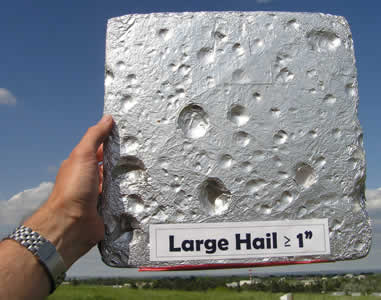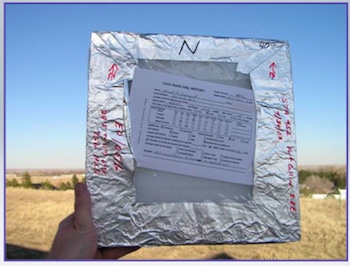|
 One of the goals of CoCoRaHS is to study hailstorm characteristics; the location, time, size, quantity and hardness of hailstones. In a hailstorm, the size and quantity of hailstones can vary quickly and over very small distances, like one mile or even just across the street. We need your help in determining when hail begins, how long it lasts, what size and type of stones, and whether or not rain has accompanied the storm. Your hail pad will help us measure the size and number of stones, but your own measurements will also help. For example, the hail pads can't tell us when the storm hit. One of the goals of CoCoRaHS is to study hailstorm characteristics; the location, time, size, quantity and hardness of hailstones. In a hailstorm, the size and quantity of hailstones can vary quickly and over very small distances, like one mile or even just across the street. We need your help in determining when hail begins, how long it lasts, what size and type of stones, and whether or not rain has accompanied the storm. Your hail pad will help us measure the size and number of stones, but your own measurements will also help. For example, the hail pads can't tell us when the storm hit.
Even in places like eastern Colorado where hail is more common than almost anywhere in North America, there will still only be a few hail-producing storms each year. What this means is that you have to be ready in advance so the hail doesn't catch you by surprise.
Follow these steps in reporting hailstorm information.
Step 1. Before the next hailstorm, make sure your hail pad is properly installed. Also make sure your CoCoRaHS Hail Report Cards are in a convenient location. Have a pencil and a ruler handy, too. Finally, read over a CoCoRaHS Hail Report Cards thoroughly so that you know what observations you will need to make when the time comes.
Step 2. If you are at home (or at the site of your reporting station) when a hailstorm hits, note the time that the hail begins as accurately as possible. The times that hail begins and ends are very important pieces of information needed by scientists. If you feel it is safe, report the onset of this storm via the CoCoRaHS website using the Hail Report Form. If you do not feel it is safe to be on the computer due to nearby lightning, wait until the storm passes. The Hail Report Form can be found on the CoCoRaHS webpage under "my data."
Step 3. Observe the hail storm in progress from a safe and secure location. Please take notes during the storm to help you remember important features from the storm, such as changes in stone size, hardness, and sudden changes in the number of stones reaching the ground. Do not expose yourself to dangerous hailstones. Keep a ruler handy. When a break in the storm gives you the opportunity, measure the diameter of the largest, the smallest and the most common sized hailstones. If you do not have a ruler, use your pocket change. The diameter of a dime is slightly less than 3/4 inch while a penny is almost precisely 3/4 inch across. The diameter of a nickel is slightly more than 3/4 inch while a quarter is slightly less than one inch across. Also check to see if the hail is clear, white, hard, soft, smooth, rough or has any other interesting properties. Take note if the hail began before, after, or at the same time that rain began.
Step 4. When the storm has ended, try to approximate the number of stones per unit area (per square foot) which hit the ground. Since the number is sometimes very large, it may be easier to record the average distance between stones on the ground. Use your hail pad to help you estimate the number of stones. If large quantities of hail fell, measure the average depth of accumulated hail on the ground. At the same time, do a quick assessment of hail damage. Most storms do very little damage except to tender plants.
Step 5. Fill out the CoCoRaHS Hail Report Card. Be sure to include your station name and number. If you were not at home, but you experienced hail at another location, a hail report is still beneficial. Make sure, however, to record your actual location accurately so the report is not accidentally associated with your normal station location.
Step 6. If you haven't yet done so, using the Hail Report card as a guide, submit a "Hail Report" via the CoCoRaHS web site (see step #2). This is an important part of the storm research.

Step 7. Retrieve your dented hail pad and replace it with a new one. Take care not to damage the hail pad for they are fragile. Artificial dents could obscure the results of the study. When you remove the hail pad, remember to carefully etch or write with a permanent marker the date, time when hail fell, and location (station number and station name) on it. Also, mark on the hail pad which direction is north. Attach the Hail Report Card to the back of the hail pad. Make a copy of the Report Card for your own records, if you desire. At your next convenient opportunity, drop the hail pad and report card in the mail and send it to:
CoCoRaHS Hail Pad - CSU
1371 Campus Delivery
Fort Collins, CO 80523
If you are unable to send in the hail pad, please photograph the pad and send it along with a copy of the hail card to: info@cocorahs.org, putting the words "hail pad" in the subject line.
Things to Remember: When measuring hail.
-
Note and record the time when hail begins and ends as accurately as possible.
-
Do not get in the path of falling hail stones.
-
Hail storms come on quickly and furiously. Be ready.
-
Three types of hail reports are encouraged:
-
Promptly notify us via our website with a " Hail Report" when hail begins at your location to give the National Weather Service a "heads up" on developing or approaching storms with a CoCoRaHS Hail Report.
-
You may also submit an additional " Hail Report" via the Internet at the end of each hailstorm providing a detailed summary of the hail observed.
-
Finally, if you have one, turn in your damaged hail pad (or close-up photographs of) along with the Hail Report Card available on the CoCoRaHS Web site (Step #7 above).
-
What if a hail storm occurred, but you were not at home to observe it?
If this happens, and it will, you will not be able to provide detailed information about the storm. If you can approximate when the storm occurred and some characteristics of the storm, try to do so. When you submit your report, make appropriate remarks expressing your uncertainty. If you do not know the time of occurrence, but you do know the date, that is also useful. Turn in the hail pad with an incomplete hail report card and a note saying, "Sorry, I wasn't home at the time of the storm."
-
What if you observer a hailstorm from a different location than your station?
If you are not at home but experience hail storms somewhere else, we welcome these reports as well. Always make sure you note the time and location as accurately as possible. Do not give your station number if you are reporting from a different location. That might confuse us.
-
What if you see some giant hailstones that are more than 2.5 inches in diameter or have very interesting shapes, sizes or other characteristics?
Every year, giant hailstones fall somewhere in across the country. Fortunately, at any specific location they are quite rare. If you see very large or very unusual hail stones, take close-up photographs, collect some samples, preserve them in your freezer, and contact your CoCoRaHS coordinator. If you see intact hail stones in excess of 5 inches in diameter, quickly and carefully wrap and freeze these stones. These are very rare and will be of great interest to scientists (and the media).
-
I have soft rounded dents in my hail pad, but I didn't see any hail.
The soft rounded dents are just deformations in the aluminum foil caused by rain, they aren't hail damage. Please just ignore them; the hail pad is still fine for hail data collection so you don't need to send it to us or replace it.
|